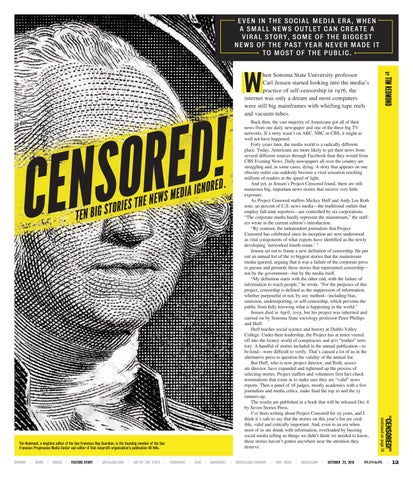EvEn in thE social mEdia Era, whEn a small nEws outlEt can crEatE a viral story, somE of thE biggEst nEws of thE past yEar nEvEr madE it to most of thE public.
W
e
n e h T s e i ig sTor
Ten b
|
NEWS
|
GREEN
|
FEATURE STORY
|
ARTS&CULTURE
|
ART OF THE STATE
|
FOODFINDS
|
FILM
|
MUSICBEAT
|
NIGHTCLUBS/CASINOS
|
THIS WEEK
|
MISCELLANY
|
OCTOBER 22, 2015
|
continued on page 14
OPINION
“CENSORED!”
Tim Redmond, a longtime editor of the San Francisco Bay Guardian, is the founding member of the San Francisco Progressive Media Center and editor of that nonprofit organization’s publication 48 Hills.
Tim Redmond
d.
e r o n g i a ws medi
Back then, the vast majority of Americans got all of their news from one daily newspaper and one of the three big TV networks. If a story wasn’t on ABC, NBC or CBS, it might as well not have happened. Forty years later, the media world is a radically different place. Today, Americans are more likely to get their news from several different sources through Facebook than they would from CBS Evening News. Daily newspapers all over the country are struggling and, in some cases, dying. A story that appears on one obscure outlet can suddenly become a viral sensation reaching millions of readers at the speed of light. And yet, as Jensen’s Project Censored found, there are still numerous big, important news stories that receive very little exposure. As Project Censored staffers Mickey Huff and Andy Lee Roth note, 90 percent of U.S. news media—the traditional outlets that employ full-time reporters—are controlled by six corporations. “The corporate media hardly represent the mainstream,” the staffers wrote in the current edition’s introduction. “By contrast, the independent journalists that Project Censored has celebrated since its inception are now understood as vital components of what experts have identified as the newly developing ‘networked fourth estate.’ ” Jensen set out to frame a new definition of censorship. He put out an annual list of the 10 biggest stories that the mainstream media ignored, arguing that it was a failure of the corporate press to pursue and promote these stories that represented censorship— not by the government—but by the media itself. “My definition starts with the other end, with the failure of information to reach people,” he wrote. “For the purposes of this project, censorship is defined as the suppression of information, whether purposeful or not, by any method—including bias, omission, underreporting, or self-censorship, which prevents the public from fully knowing what is happening in the world.” Jensen died in April, 2015, but his project was inherited and carried on by Sonoma State sociology professor Peter Phillips and Huff. Huff teaches social science and history at Diablo Valley College. Under their leadership, the Project has at times veered off into the looney world of conspiracies and 9/11 “truther” territory. A handful of stories included in the annual publication—to be kind—were difficult to verify. That’s caused a lot of us in the alternative press to question the validity of the annual list. But Huff, who is now project director, and Roth, associate director, have expanded and tightened up the process of selecting stories. Project staffers and volunteers first fact-check nominations that come in to make sure they are “valid” news reports. Then a panel of 28 judges, mostly academics with a few journalists and media critics, make final the top 10 and the 15 runners-up. The results are published in a book that will be released Oct. 6 by Seven Stories Press. I’ve been writing about Project Censored for 25 years, and I think it’s safe to say that the stories on this year’s list are credible, valid and critically important. And, even in an era when most of us are drunk with information, overloaded by buzzing social media telling us things we didn’t think we needed to know, these stories haven’t gotten anywhere near the attention they deserve.
by
! d e r o s n e C
hen Sonoma State University professor Carl Jensen started looking into the media’s practice of self-censorship in 1976, the internet was only a dream and most computers were still big mainframes with whirling tape reels and vacuum tubes.
RN&R
|
13












